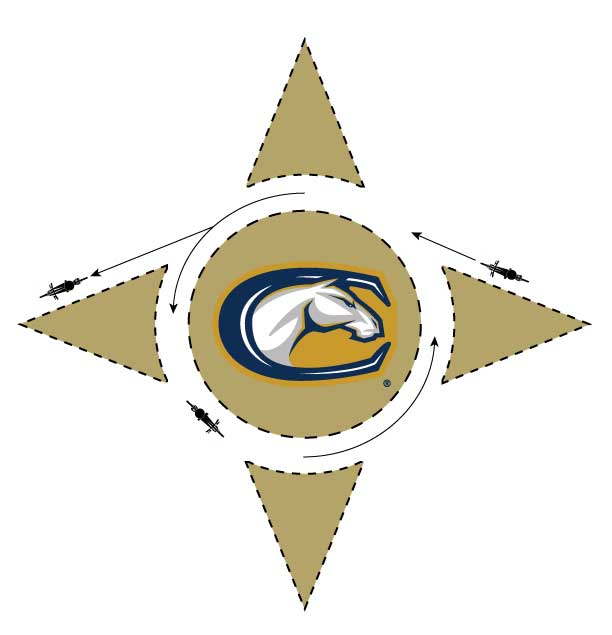Watch BEEP (Bicycle Safety Video)
The BEEP (Bicycle Education and Enforcement Program) video is a quick way to learn about cycling on campus and knowing your rights.
Upcoming Educational Events
Interested in learning more about how to be a successful cyclists here in Davis? Good news, we're here to help you.
Below you can find a link to one of our upcoming events, should there be any. Should you be interested in having us come out for a special event or a to deliver specific education, contact us at bikeprogram@ucdavis.edu
CyclingSavvy Online
CyclingSavvy Online is a education program available via Canvas to any UC Davis affiliate. The entire "CyclingSavvy Basics" course takes a little under two hours to complete, and goes over some valuable skills for all levels of cyclists. We hope that you find it provides you with the knowledge and confidence to ride safely on your commutes, while running errands, or while biking for recreation. It is our hope that by putting this material into practice, you can make all of your cycling experiences more enjoyable and less stressful.
Access it via Canvas.
Know Your Rights (Cycling Safety) -- See our 4 safety tips
There are a lot of experienced cyclists in Davis. Being an experience cyclists means knowing your rights as well as the rules of the road.
- 1. Obey all traffic laws
- According to the California Vehicle Code, every person riding a bicycle upon a street or highway has all of the rights and responsibilities of the driver of a motor vehicle. On campus traffic regulations are strictly enforced. You may be cited for running stop signs, riding at an unsafe speed for conditions, riding on the wrong side of the road or on sidewalks, wearing headphones while riding, not having legal brakes, etc. Cyclists are required by state law to use front white lights, rear red reflectors, pedal and side reflectors at night. Additional lights - especially rear red flashers, reflectors, and light colored clothing are a good idea.
See Rules of the Road
- 2. Maintain control of your bicycle
- Ensure your bicycle is the right size and properly adjusted to fit you.
• A properly-fitted bicycle is more comfortable and easier to control.
• A bicycle shop can help you choose the correct size bicycle.
• Ensure your bicycle is in good working order by inspecting it regularly.
- 3. Wear a helmet (protect your investment)
 Helmets can greatly reduce the risk of head injury. Don't "hit the road" without one. But remember: even the best helmet has limitations and they don't prevent crashes.
Helmets can greatly reduce the risk of head injury. Don't "hit the road" without one. But remember: even the best helmet has limitations and they don't prevent crashes.
• Defensive cycling is the key to bike safety.
• Properly-fitted helmets provide protection from a potentially life-threatening head injury.
• By law, bicycle riders under 18 years old must wear a bicycle helmet while riding on a public road (CVC §21212).
• Wear your helmet per manufacturer directions
- 4. Be visible and alert
- • Use hand signals and eye contact to communicate your intentions.
• Even if you obey all traffic laws, there is always a risk of a collision.- • Be prepared to stop for vehicles waiting at stop signs, in driveways, or parking spaces, which may suddenly pull out in front of you.
- • Be prepared to take evasive action relating to vehicles that have just passed you and may turn right, as well as vehicles coming the opposite way that may turn left in front of you.
- • Use hand signals before making turns or changing lanes to warn traffic around you. You do not have to keep your arm extended while completing maneuvers; always have at least one hand on the handlebars to maintain control.
- • To signal a left turn, look behind you, over your left shoulder, and then extend your left arm out.
- • To signal a right turn, hold your left arm up with your elbow bent.
- • To signal that you are slowing or stopping, extend your left arm down.
- • Ride in a safe lane position with traffic
Additional Tips to Know When Riding in Traffic
|
Use Hand Signals | Signal your intention to other drivers; your movements affect them. Hand signals tell everyone what you intend to do. Signal as a matter of law, courtesy, and self-protection. |
|
|
|
Don't Weave | Don't ride to the curb and weave between parked cars. Motorists may not see you when you try to move back into traffic. |
|
|
|
|
KNOW YOUR ROUNDABOUT
 One of the more prominent features of the campus cycling environment is the traffic circle or roundabout. There are over a dozen such intersections around the campus and several in the city. Some are at the junctions of roadways, others at bike path crossings, and some where bike paths meet roads.
One of the more prominent features of the campus cycling environment is the traffic circle or roundabout. There are over a dozen such intersections around the campus and several in the city. Some are at the junctions of roadways, others at bike path crossings, and some where bike paths meet roads.
There are two important rules to remember when approaching a traffic circle: Always ride counterclockwise through the circle, and always yield right-of-way to any bike or vehicle already in the circle. Signaling your turns is especially helpful in circles, and be sure to watch out for others and adjust your speed or turns accordingly. Not everyone will necessarily understand or obey these right-of-way or yield rules, so ride defensively!
Choose Your Bicycle: Buy a Quality Bicycle, Options From $ - $$$$
Bring your bicycle from home - $ (free, affordable)
If you already have a bicycle, the most affordable option is to bring it with you to campus! Before riding your bicycle, make sure it is in good condition. This means legal brakes, safe tires, lights and reflectors. If you are unsure of your bike's condition, have it checked out by a qualified mechanic. Buy and install fenders before the first rain – believe us, you'll want them! If you need to ship your bicycle, there are several options you might consider:
- BikeFlights ships nationally and internationally, specializing in shipping bicycles safely. | www.bikeflights.com
- FedEx ships all over the world. Contact them for rates and details. | www.fedex.com
- UPS ships all over the world, Contact them for rates and details. | www.ups.com
Students who do not wish to transport a bicycle from home or feel that their old bicycle is unsuitable for everyday use can take advantage of local sales, service and repair at one of Davis' many bicycle retailers.
CAUTION WHEN BUYING USED BICYCLES
 Thrifty shoppers should be weary when checking out local yard sales and classified ads. There is a secondary market on the rise that sells stolen bicycles, which are often unregistered and difficult to track. Do not support thieves by purchasing bicycles from them. If the price is too good to be true, it probably is! You should always buy from a reputable shop. Check all serial numbers on www.bikeindex.org before purchase.
Thrifty shoppers should be weary when checking out local yard sales and classified ads. There is a secondary market on the rise that sells stolen bicycles, which are often unregistered and difficult to track. Do not support thieves by purchasing bicycles from them. If the price is too good to be true, it probably is! You should always buy from a reputable shop. Check all serial numbers on www.bikeindex.org before purchase.
Purchase a fixer-upper or gently used bicycle - $$ (affordable, spend a little money)
Used bikes are an affordable option, especially for those new to cycling. The cost of parts and a tune-up are nominal compared to what you would spend on a new bicycle. Plus, fixer-uppers and gently used bicycles are less likely to be stolen. Where to find used and affordable fixer-uppers:
- ASUCD Bike Barn is located on the UC Davis campus and is the best bicycle resource for the Aggie Community. | bikebarn.ucdavis.edu
- The Bicycle Auction sells used, as-is condition, bicycles that are collected from campus at an online auction monthly. | [link]
- Green Bicycle Depot is a family-owned and operated bike shop in Davis that sells quality new and used bicycles. | greenbicycledepot.com
- Bike Swap is hosted by César Chávez Elementary School in the Spring where you can buy, donate or sell a bicycle. | www.davisbikeswap.org
- Davis Bike Collective is a volunteer-run nonprofit self-service bike shop where visitors can repair bicycles they own. | davisbikecollective.org
CAUTION WHEN BUYING USED BICYCLES
 Thrifty shoppers should be weary when checking out local yard sales and classified ads. There is a secondary market on the rise that sells stolen bicycles, which are often unregistered and difficult to track. Do not support thieves by purchasing bicycles from them. If the price is too good to be true, it probably is! You should always buy from a reputable shop. Check all serial numbers on www.bikeindex.org before purchase.
Thrifty shoppers should be weary when checking out local yard sales and classified ads. There is a secondary market on the rise that sells stolen bicycles, which are often unregistered and difficult to track. Do not support thieves by purchasing bicycles from them. If the price is too good to be true, it probably is! You should always buy from a reputable shop. Check all serial numbers on www.bikeindex.org before purchase.
Purchase a new bicycle - $$$-$$$$ (more of an investment)
With bike shops conveniently located within a few blocks of each other, variety, selection and competitive prices are ensured. Qualified bicycle shops will be able to outfit anyone with the right size and style of bicycle, as well as the appropriate security devices. For those wanting to spend a little bit more money, purchasing a new bicycle will allow you to be more selective, with little need to have work done on the bicycle prior to riding. See our recommendations for reputable bike shops right here in Davis:
- ASUCD Bike Barn is located on the UC Davis campus and is the best bicycle resource for the Aggie Community. | bikebarn.ucdavis.edu
- Green Bicycle Depot is a family-owned and operated bike shop in Davis that sells quality new and used bicycles. | greenbicycledepot.com
- Freewheeler Bicycle Center is a family-owned bicycle shop in Downtown Davis with a variety of bikes available. | www.freewheelerbikes.com
- Ken's Bike-Ski-Board is a Davis institution selling bicycles (and snow gear) since 1988. | kensbikeski.com
BUY A BIKE FROM THE BIKE BARN
See the current inventory of bicycles for sale at the ASUCD Bike Barn.
Questions? Contact the Bike Barn!
Monday-Friday, 9 a.m.-4p.m.
help.bikebarn@gmail.com
530-752-2575
Bicycle Repair Stations
Bicycle repair stations are located throughout campus and are quick way to make those needed on-the-go repairs. Please see the Bike Repair Station Map for locations around campus.
DIY Bicycle Repair

DIY: Learn to repair your own bicycle
- Campus Recreation Craft Center often offers classes in bicycle maintenance. Look for their courses here
- Davis Bike Collective has volunteers to help guide you to teach yourself to repair your bicycle. They also offer a Women-Trans-Femme for those wishing to learn more in a safe space. Learn more
- DIY Repair Stations are scattered around campus with tools available for your use. See locations
- Plus, keep an eye out on classes offered by the Bicycle Program!

